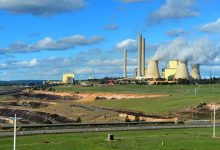The Victorian Environment Protection Authority and the operators of three of Victoria’s largest coal fired power stations have been taken to court over failures to limit pollution in a major test of new climate change laws.
Legal action has been launched by Environment Victoria in the Victorian Supreme Court and will argue that the Victorian EPA has failed to enforce climate change legislation introduced by the Andrews government designed to curb the state’s greenhouse gas emissions.
The environment group will argue that state environmental regulators ignored the new laws when approving new licences for Loy Yang A and Loy Yang B, owned by AGL Energy and Alinta, respectively, and EnergyAustralia’s Yallourn power station.
“The Andrews government passed nation-leading climate change legislation in 2017, but Victoria’s environment watchdog chose to ignore it when making a crucial decision about coal power station licences this year,” Environment Victoria CEO Jono La Nauze said.
“We believe the EPA has failed to protect the health of the community and the environment so we’re putting the matter before a judge to decide.”
The case will hinge on whether the EPA fulfilled its obligations under two pieces of Victorian state legislation, the Climate Change Act and the Environment Protection Act.
The Victorian Climate Change legislation was introduced in 2017, committing the state government to zero emissions targets and requiring government agencies to include climate change considerations when making decisions and setting new policies.
Earlier this year, the Victorian EPA made decisions about the licences for the three coal-fired power stations, all located in the Latrobe Valley, which did not impose limits on the greenhouse gas emissions that they are responsible for and only placed limited restrictions on other air pollutants.
In launching the legal action, Environment Victoria will argue that the EPA failed to fulfil its duties when it undertook a review of the licences issued to the power stations.
The case will serve as an early test of the Victorian climate change laws and follows a ruling of the NSW Land and Environment Court that found that the NSW EPA had failed to properly regulate climate change impacts.
The environment group said that the coal-fired power stations were responsible for much of Victoria’s air pollution, and it was important that regulators like the EPA used the powers available to them to limit the impact on both the environment and the broader community.
“Coal-burning power stations are by far the biggest cause of climate change in our state, responsible for 40 per cent of Victoria’s greenhouse gas emissions. They’re also the biggest single source of toxic air pollution, including sulfur dioxide, oxides of nitrogen, fine particle pollution and mercury,” La Nauze said.
“A study in 2020 found that pollution from Victorian coal-burning power stations causes an estimated 205 premature deaths, 259 low birth-weight babies, and 4376 asthma symptoms in children each year.
“But currently, the EPA is letting these power stations emit toxic pollution at levels that wouldn’t be allowed in the United States, Europe or China.”
Environment Victoria will be represented by Environmental Justice Australia, which said it was important that government regulators were held to account for enforcing the environmental protections legislated by parliament.
“It’s vital that our laws are applied as intended – to protect community health and our environment and reflect developing community expectations,” Environmental Justice Australia’s principal lawyer, Nick Witherow, said.
“If the EPA will not implement the laws that were enacted to protect the air the community breathes and the climate we live in, then it is in the public interest that they are held accountable and their decisions tested in court.
“This case adds to a wave of climate litigation in Australia and around the world, including the recent successful case brought by bushfire survivors that found the NSW EPA failed in its duty to address climate change and must take action to address greenhouse gas emissions.”
On Wednesday, the board of AGL Energy was rebuked by its shareholders – frustrated by the energy company’s sluggish response to changes in Australia’s energy market – who backed an AGM resolution calling for the company to set and publish strategies for transforming the business consistent with the Paris Agreement goals to limit global warming.










